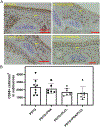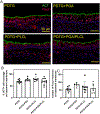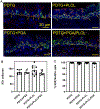Assessing the Biocompatibility and Regeneration of Electrospun-Nanofiber Composite Tracheal Grafts
- PMID: 37578209
- PMCID: PMC10864676
- DOI: 10.1002/lary.30955
Assessing the Biocompatibility and Regeneration of Electrospun-Nanofiber Composite Tracheal Grafts
Abstract
Objective: Composite tracheal grafts (CTG) combining decellularized scaffolds with external biomaterial support have been shown to support host-derived neotissue formation. In this study, we examine the biocompatibility, graft epithelialization, vascularization, and patency of three prototype CTG using a mouse microsurgical model.
Study design: Tracheal replacement, regenerative medicine, biocompatible airway splints, animal model.
Method: CTG electrospun splints made by combining partially decellularized tracheal grafts (PDTG) with polyglycolic acid (PGA), poly(lactide-co-ε-caprolactone) (PLCL), or PLCL/PGA were orthotopically implanted in mice (N = 10/group). Tracheas were explanted two weeks post-implantation. Micro-Computed Tomography was conducted to assess for graft patency, and histological analysis was used to assess for epithelialization and neovascularization.
Result: Most animals (greater than 80%) survived until the planned endpoint and did not exhibit respiratory symptoms. MicroCT confirmed the preservation of graft patency. Grossly, the PDTG component of CTG remained intact. Examining the electrospun component of CTG, PGA degraded significantly, while PLCL+PDTG and PLCL/PGA + PDTG maintained their structure. Microvasculature was observed across the surface of CTG and infiltrating the pores. There were no signs of excessive cellular infiltration or encapsulation. Graft microvasculature and epithelium appear similar in all groups, suggesting that CTG did not hinder endothelialization and epithelialization.
Conclusion: We found that all electrospun nanofiber CTGs are biocompatible and did not affect graft patency, endothelialization and epithelialization. Future directions will explore methods to accelerate graft regeneration of CTG.
Level of evidence: N/A Laryngoscope, 134:1155-1162, 2024.
Keywords: Tracheal replacement; animal model; biocompatible splint; regenerative medicine.
© 2023 The American Laryngological, Rhinological and Otological Society, Inc.
Conflict of interest statement
Conflicts of Interest: None
Figures








Similar articles
-
Tissue-engineered composite tracheal grafts create mechanically stable and biocompatible airway replacements.J Tissue Eng. 2022 Jun 26;13:20417314221108791. doi: 10.1177/20417314221108791. eCollection 2022 Jan-Dec. J Tissue Eng. 2022. PMID: 35782992 Free PMC article.
-
Successful Early Neovascularization in Composite Tracheal Grafts.Otolaryngol Head Neck Surg. 2023 Oct;169(4):1035-1040. doi: 10.1002/ohn.350. Epub 2023 Apr 10. Otolaryngol Head Neck Surg. 2023. PMID: 37036314 Free PMC article. Clinical Trial.
-
Mouse Model of Tracheal Replacement With Electrospun Nanofiber Scaffolds.Ann Otol Rhinol Laryngol. 2019 May;128(5):391-400. doi: 10.1177/0003489419826134. Epub 2019 Jan 30. Ann Otol Rhinol Laryngol. 2019. PMID: 30700095 Free PMC article.
-
Optimization of Chondrocyte Viability in Partially Decellularized Tracheal Grafts.Otolaryngol Head Neck Surg. 2023 Nov;169(5):1241-1246. doi: 10.1002/ohn.404. Epub 2023 Jun 14. Otolaryngol Head Neck Surg. 2023. PMID: 37313949 Free PMC article.
-
Clinical Translation of Tissue Engineered Trachea Grafts.Ann Otol Rhinol Laryngol. 2016 Nov;125(11):873-885. doi: 10.1177/0003489416656646. Epub 2016 Jul 12. Ann Otol Rhinol Laryngol. 2016. PMID: 27411362 Free PMC article. Review.
Cited by
-
Organic and Synthetic Substitutes in Tracheal Reconstruction: A Scoping Review (2015-2025).Bioengineering (Basel). 2025 Jun 27;12(7):704. doi: 10.3390/bioengineering12070704. Bioengineering (Basel). 2025. PMID: 40722395 Free PMC article. Review.
References
-
- Tracheal disease. Tracheal Disease ∣ Michigan Medicine. (n.d.). Retrieved January 9, 2022, from https://www.uofmhealth.org/conditions-treatments/surgery/tracheal-disease
-
- Delaere P, Vranckx J, Verleden G, et al. Tracheal allotransplantation after withdrawal of immunosuppressive therapy. New England Journal of Medicine 2010; 362: 138–145. - PubMed
Publication types
MeSH terms
Substances
Grants and funding
LinkOut - more resources
Full Text Sources
Research Materials

